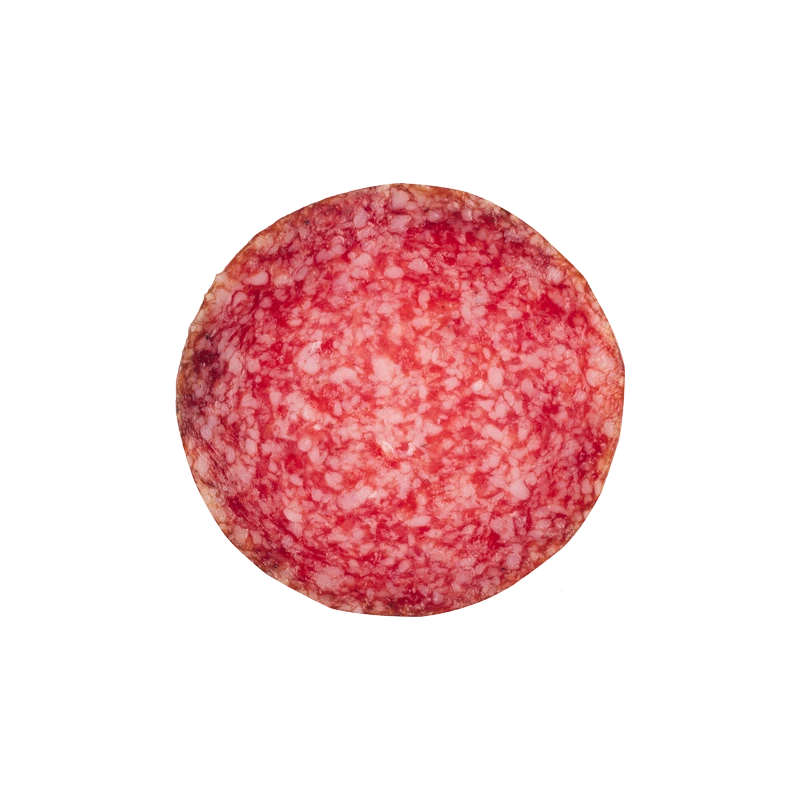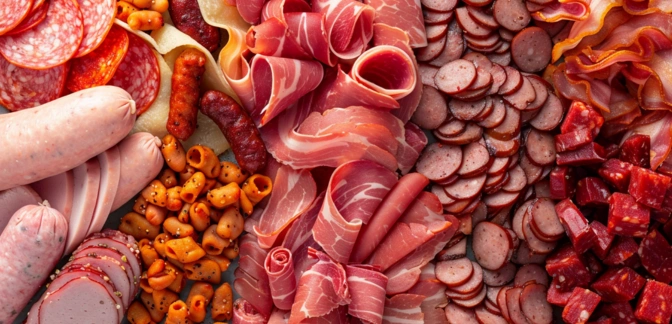Pepperoni — Nutrients, Health Benefits, And Shopping Tips

Written by Listonic Team
Last update on September 4, 2024
Pepperoni nutrients
Nutrition facts
Amount per 100 g
Calories
🔥 504 kcal
| Nutrition per: 100 g | Value | % Daily Value* |
|---|---|---|
| Carbs | 2 g | 0.73% |
| Fiber | 0 g | - |
| Sugars | 0 g | - |
| Glycemic Index | 28 | - |
| Protein | 24 g | 48% |
| Sodium | 1650 mg | 71.74% |
| Total Fat | 45 g | 57.69% |
*The % of Daily Value (DV) tells you how much a nutrient in a serving of food contributes to a daily diet. 2,000 calories a day is used for general nutrition advice.
24 g
💪 High Protein Content
28
🟢 Low Glycemic Index
Pepperoni facts & tips
Health benefits
- High in protein, essential for muscle growth, repair, and overall body function.
- Rich in flavor, which can make dishes more enjoyable and satisfying.
- Contains essential vitamins and minerals such as Vitamin B12, zinc, and selenium, which support overall health and well-being.
- Provides energy from fats and proteins, making it a good source of fuel for the body.
Health risks
- High fat content particularly in traditional pepperoni, which can raise cholesterol levels and increase the risk of heart disease when consumed frequently.
- High sodium content which can contribute to hypertension and increased cardiovascular risks when consumed frequently.
- Presence of nitrates and nitrites used in curing pepperoni, which have been linked to an increased risk of cancer, particularly colorectal cancer.
- Risk of contamination with harmful bacteria such as Listeria or Salmonella, particularly if the pepperoni is not properly stored or handled.
How to choose pepperoni
Pepperoni should be evenly marbled with fat, vibrant red in color, and have a spicy, smoky aroma. The slices should be uniform and not stick together, indicating they have been properly cured and stored.
Avoid pepperoni that is excessively oily or has a pale color, as it may indicate under-curing or poor quality ingredients. Pepperoni that smells sour or has mold should also be avoided, as it is not safe for consumption.

How to store pepperoni
Pepperoni should be stored in the refrigerator, preferably in its original packaging or an airtight container. Refrigeration helps maintain its flavor and texture for up to three weeks.
Air exposure can cause pepperoni to dry out and spoil. Avoid leaving it uncovered or near strong-smelling foods. Always ensure the container is tightly sealed to keep it fresh and prevent contamination.
✅ Extra Tip
How long does it last?
Pepperoni can last for 1-2 weeks in the refrigerator once opened. For longer storage, pepperoni can be frozen for up to 2-3 months.
What to do with leftovers?
Leftover pepperoni can be used in a variety of savory and flavorful dishes. Slice it and add to pizzas, flatbreads, or sandwiches for a spicy and meaty topping, or chop it up and mix into a pasta dish with your favorite sauce. Pepperoni is also great when added to omelets, frittatas, or quiches with eggs, cheese, and vegetables.
Use pepperoni in a casserole or pasta bake with cheese, sauce, and breadcrumbs, or mix it into a salad with greens, tomatoes, and olives for added flavor. If you have a lot of pepperoni, consider making a batch of pepperoni chips by baking the slices until crispy, perfect for snacking or adding to soups and stews. Pepperoni can also be used as a topping for stuffed peppers with rice, cheese, and sauce, or mixed into a cheese dip for serving with crackers or bread. For a quick snack, enjoy pepperoni slices on their own or with a side of mustard or dipping sauce.
👨⚕️️ Medical disclaimer
Discover products from other categories
Listonic Team
Fact-checked
Our editorial team checked this article to make sure it was accurate at the time of publishing it.
Get the top-rated shopping list app on your phone!







